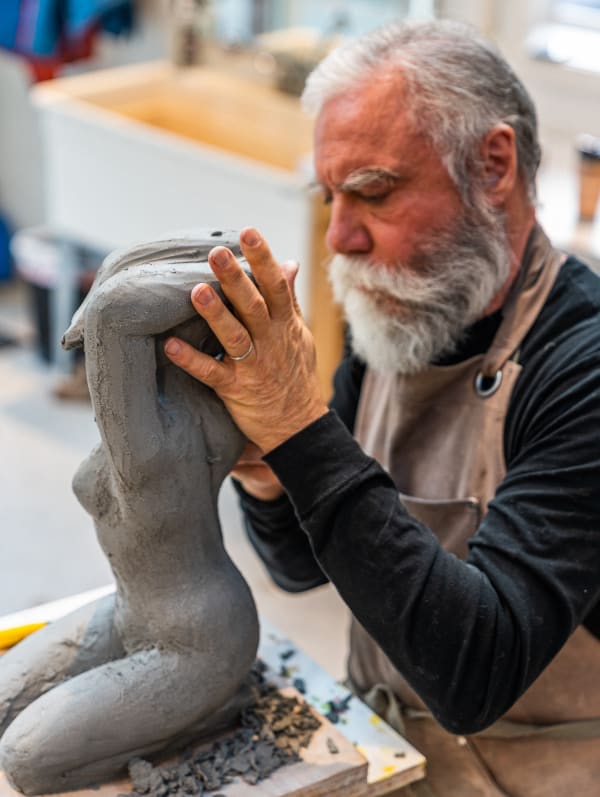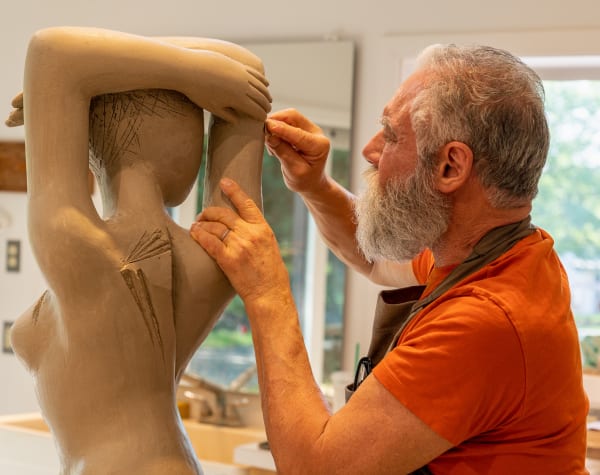Emilio DiIorio has a compassion for humanity that is expressed through his hands. As a former surgeon, systems engineer, and CEO, his connection with humanity occured between his hands and a patient's body. As an artist, the result of that physical connection infuses his artwork when he draws, paints, or sculpts. For DiIorio, scalpel and paintbrush are synonymous; he handles both with equal precision and passion; and with both tools he expertly shapes the human figure.
Artist Emilio DiIorio, an Italian American, was born on the Upper East Side of Manhattan. In the 1960s, he studied engineering at New York University. It was during these years that he was first introduced to painting and sculpture. DiIorio keenly remembers its early and undeniable pull. He explored the Museum of Modern Art, the Metropolitan Museum of Art, and other museums in New York City. In these rich exhibition spaces he developed a lifelong connection to both the old masters and modern art.
Engineering school sparked an interest in drawing and design. His skills with graphite developed as he took graphic design in which the expectation was to draw. After graduating with a degree in Engineering, DiIorio spent time as a systems engineer at Grumman Aerospace Corporation. There he was exposed to the Apollo space program and the aspect of lunar module engineering that focused on human factors. The human factor studies involved the effect of lift-off on the human body. This was DiIorio’s first introduction to human anatomy, particularly to the musculoskeletal system.
During his time at Grumman, DiIorio enrolled in the MBA program at New York University to study economics. It was during this period of social and political unrest in the United States that DiIorio realized his passions no longer lay in engineering or business, but rather in anatomy and art. Soon, he decided to discontinue his career and graduate studies to move overseas. For DiIorio, Europe held a distinctive draw: it would return him to his roots and immerse him in art.
Having been accepted at the University of Ghent to study anatomy, DiIorio sold his belongings and left for Belgium. He spent the summer in language school learning Dutch. At Ghent, DiIorio studied under anatomist, Professor Dr. J. Fautrez. Dr. Fautrez fascinated DiIorio. He told the story of the human body through art. DiIorio recalls Dr. Fautrez standing in front of a huge lecture hall armed only with a projector and four colored markers. Dr. Fautrez's storytelling combined with his colored drawings significantly affected the young Italian-American student. To this day, DiIorio explains anatomy by telling a story and drawing with markers.
During his time at Ghent, DiIorio made frequent visits to the nearby city of Brugge where he discovered Michelangelo's Brugge Madonna, which had a profound influence on his interest in figurative sculpture. He then moved to Antwerp to begin his medical studies; and soon discovered Middelheim Park, an outdoor sculpture museum which includes figurative works by Henry Moore and Aristide Maillol. DiIorio became increasingly fascinated with the shape and form of sculpture. He also took the opportunity to travel to Italy and studied Etruscan and Greco-Roman art.
DiIorio returned to the US Eastern seaboard to complete his medical degree and trained in Orthopedic surgery at Boston University and the Lahey Clinic. Afterwards, DiIorio started a hospital network in eastern Pennsylvania and New Jersey. This location gave him easy access to New York City and the growing exodus of artists to nearby communities. DiIorio built a team of supporting artisans and craftsmen as well as expanding his studios in eastern Pennsylvania.
As a lifelong student of art history, he extensively studies and is influenced by artists such as the Italian painter and sculptor Marino Marini who combined the primitive with the present, the self-taught Italian sculptor Giaccomo Manzu, and the great Surrealist sculptor of the twentieth-century figure, Swiss visionary Alberto Giacometti. DiIorio frequently travels to Europe to deepen his understanding of ancient and classical art.
DiIorio’s work blends classical and contemporary art – a mixture of figurative, abstraction and realism. Among the contemporary artists influencing DiIorio is West Coast artist, Manuel Neri. Neri evokes emotion specifically by varying the pose and gesture of the female figure. Color, form, and material all play a meaningful role in this depiction.
For DiIorio, art is not just decorative, rather, it is an emotional and visceral experience. He uses color to bring out inner emotion; it may or may not realistically highlight the anatomy, but it is used as an integral element in his artwork. His paintings and sculptures often have no definitive face or character. At times, various parts of the figure are not included, such as limbs, hands, and heads. In the end it is not about those details, it is about the overall shape, form, and gesture of the figure. DiIorio’s use of fragmentation of the form is also a nod to the sense of beauty seen in the Elgin marbles, the late unfinished works of Michelangelo, and the partial figures of Rodin.
The diversity of DiIorio’s background as an engineer, surgeon, and CEO, combined with his love of art, have lead to an abundant and vibrant studio practice spanning over 40 years. He works extensively in marble, bronze, clay, plaster, aluminum, stainless steel, mixed media, and collage, engaging with both abstraction and female figurative representation in each medium.




